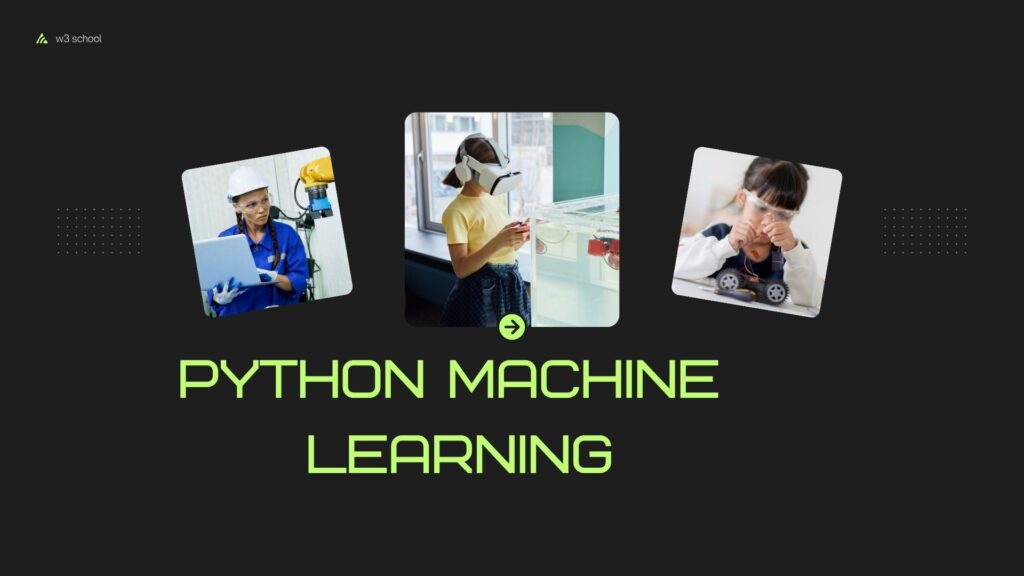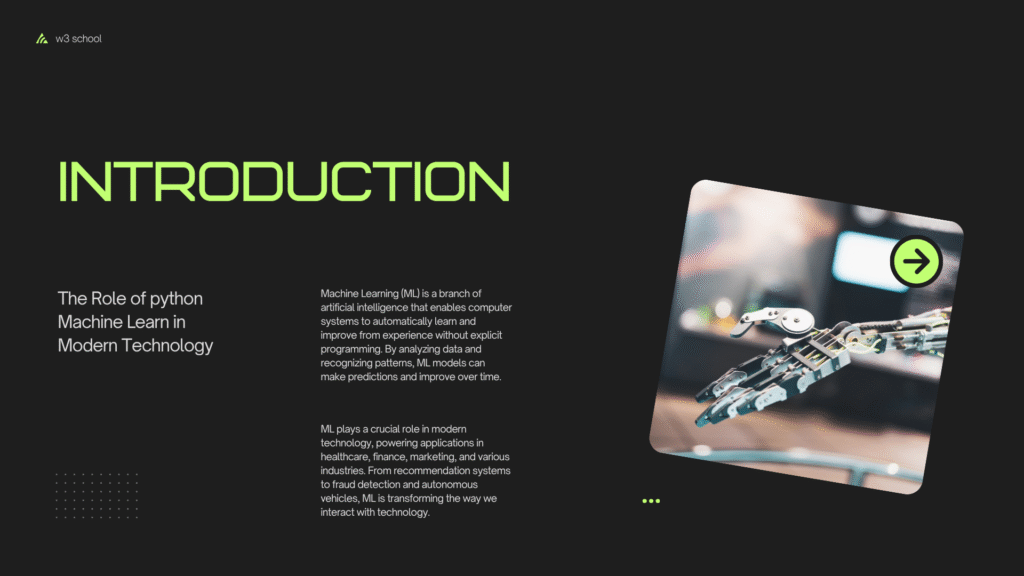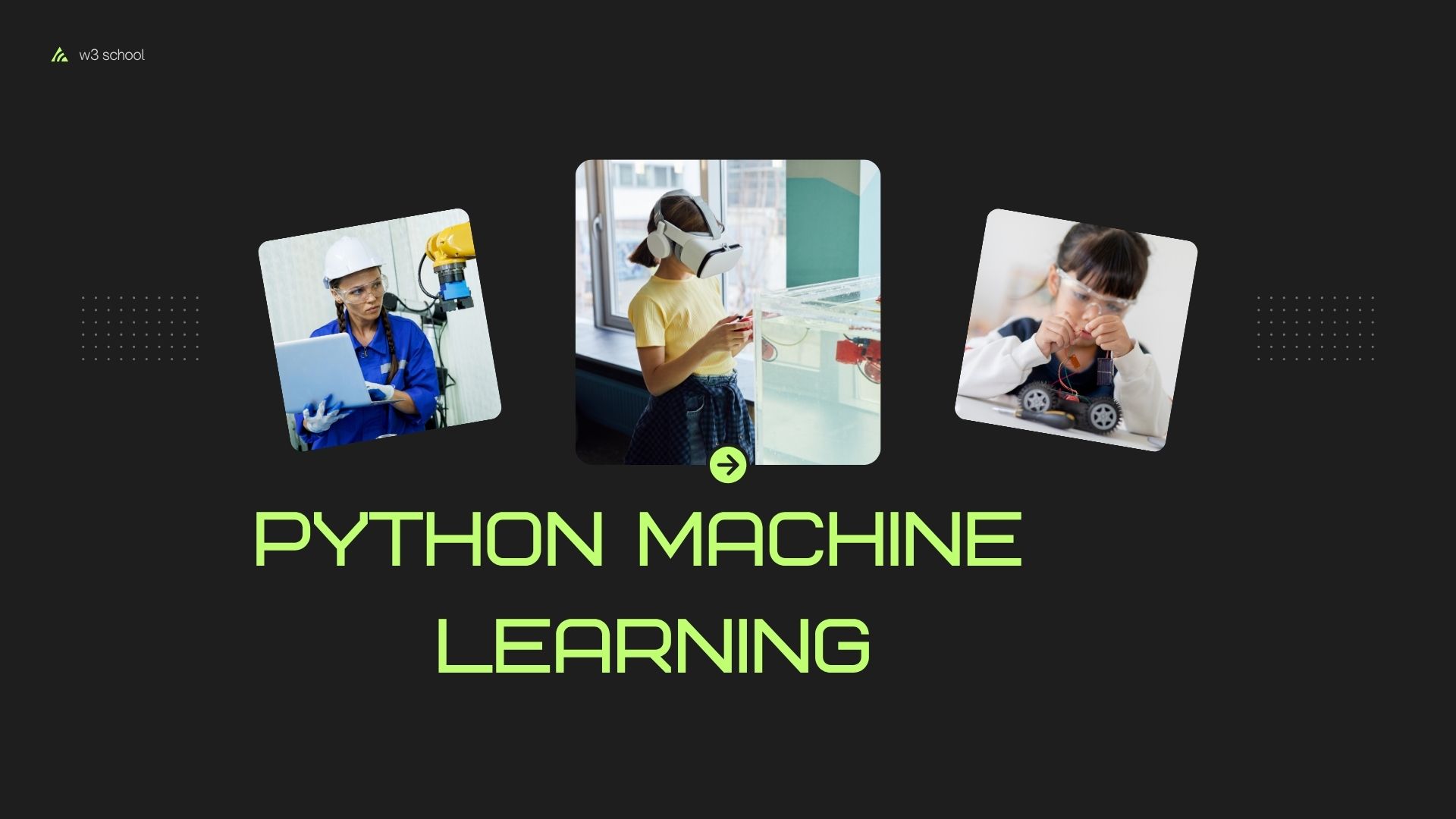Discover why Python is the undisputed king for Machine Learning and AI. This ultimate guide covers libraries, frameworks, real-world applications.

Why Python Dominates the Machine Learning Landscape
In the rapidly evolving world of technology, Machine Learning (ML) and Artificial Intelligence (AI) have transitioned from academic curiosities to core business imperatives. From the recommendation engines of Netflix and Amazon to the fraud detection systems in banking and the voice assistants in our homes, ML is reshaping industries. And at the heart of this revolution lies a versatile, powerful, and accessible programming language: Python.
But why Python? In a field populated with languages like R, C++, and Julia, Python has emerged as the undisputed leader. A glance at industry surveys, job postings, and GitHub repositories reveals a clear consensus: Python is the lingua franca of data science and machine learning.
This isn’t by accident. Python’s ascendancy is the result of a perfect storm of factors: its simplicity, a rich ecosystem of specialized libraries, strong community support, and unparalleled versatility. This article is your definitive guide to understanding and leveraging Python for Machine Learning. We will delve deep into the reasons behind its dominance, explore its essential libraries, walk through a complete ML project, discuss advanced AI concepts, and provide a concrete learning path to take you from novice to practitioner.

Section 1: The Unbeatable Synergy – Why Python and ML Are a Perfect Match
Before we dive into the code and libraries, it’s crucial to understand the foundational reasons why Python has become the go-to choice for ML developers and data scientists worldwide.
1.1 Simplicity and Readability: Lowering the Barrier to Entry
Machine Learning is inherently complex, involving advanced mathematics, statistics, and algorithm theory. Python’s clean, concise, and readable syntax acts as a force multiplier. It allows developers and researchers to focus on solving ML problems rather than wrestling with intricate language syntax.
Compare a simple operation in Python and C++:
Python:
python
# Calculate the square of even numbers in a list numbers = [1, 2, 3, 4, 5] squares_of_evens = [x**2 for x in numbers if x % 2 == 0] print(squares_of_evens) # Output: [4, 16]
C++:
cpp
#include <iostream>
#include <vector>
#include <algorithm>
int main() {
std::vector<int> numbers = {1, 2, 3, 4, 5};
std::vector<int> squares_of_evens;
for (int x : numbers) {
if (x % 2 == 0) {
squares_of_evens.push_back(x * x);
}
}
for (int val : squares_of_evens) {
std::cout << val << " ";
}
return 0;
}The Python code is almost pseudocode, making it easier to prototype ideas quickly and collaborate effectively. This readability accelerates the entire ML lifecycle, from research and development to deployment and maintenance.
1.2 The Powerhouse Ecosystem of Libraries and Frameworks
Python’s greatest strength in ML is its vast, pre-built ecosystem. Instead of writing complex numerical computations from scratch, you can leverage battle-tested libraries. This “batteries-included” philosophy means you can stand on the shoulders of giants.
The core libraries form a stack:
- NumPy provides the foundation for numerical computation.
- Pandas builds on NumPy for data manipulation and analysis.
- Scikit-Learn offers simple and efficient tools for classical ML.
- TensorFlow and PyTorch enable the creation of sophisticated deep learning models.
We will explore these in detail in the next section.
1.3 Strong Community and Extensive Documentation
A vibrant community is a critical asset for any technology. Python boasts one of the largest and most active communities in the world. For an ML practitioner, this means:
- Abundant Learning Resources: Countless tutorials, courses, books, and blog posts.
- Q&A Support: Platforms like Stack Overflow are filled with Python/ML discussions and solutions.
- Continuous Innovation: The community constantly contributes new libraries, improves existing ones, and shares best practices.
1.4 Versatility and Scalability: From Prototype to Production
Python is a general-purpose language. The same language you use to build a ML model can be used to create a web application (with Django/Flask), connect to databases, handle system automation, or perform network programming. This makes it ideal for building end-to-end ML systems.
Furthermore, with tools like Docker, Kubernetes, and cloud services (AWS SageMaker, Google AI Platform, Azure Machine Learning), Python-based ML models can be scaled to serve millions of users efficiently and reliably.
1.5 Robust Integration and Support
Python acts as a “glue” language, seamlessly integrating with other languages and systems. High-performance C/C++ code can be wrapped in Python (as seen in libraries like NumPy and TensorFlow), giving you the best of both worlds: the ease of Python and the speed of compiled languages. It also has excellent support for various data formats (JSON, CSV, Parquet) and databases (SQL, NoSQL).
Section 2: The Essential Python Machine Learning Stack: A Deep Dive into Key Libraries
To truly master ML with Python, you must become proficient with its core libraries. Let’s dissect the most important ones.
2.1 NumPy: The Foundation of Numerical Computing
NumPy (Numerical Python) is the fundamental package for scientific computing. It provides a high-performance multidimensional array object (ndarray) and tools for working with these arrays.
Why it’s indispensable for ML:
- Efficiency: ML algorithms involve heavy mathematical operations on large datasets. NumPy arrays are stored more compactly in memory and are significantly faster than native Python lists for numerical operations because their core is written in C.
- Broadcasting: A powerful mechanism that allows NumPy to work with arrays of different shapes during arithmetic operations, eliminating the need for explicit loops.
- Linear Algebra: Built-in functions for operations like matrix multiplication, determinants, eigenvalues, and SVD, which are the bedrock of many ML algorithms.
Example: Vectorized Operations with NumPy
python
import numpy as np # Creating arrays a = np.array([1, 2, 3, 4, 5]) b = np.array([6, 7, 8, 9, 10]) # Vectorized operation (fast and concise) result = a * 2 + b print(result) # Output: [ 8 11 14 17 20] # Matrix operations matrix_a = np.random.rand(3, 3) matrix_b = np.random.rand(3, 3) product = np.dot(matrix_a, matrix_b) # Matrix multiplication determinant = np.linalg.det(product) # Calculate determinant
2.2 Pandas: Data Manipulation and Analysis Made Easy
Pandas is built on top of NumPy and provides high-level data structures and tools designed to make data analysis fast and easy. The two primary data structures are Series (1-dimensional) and DataFrame (2-dimensional), which can be thought of as an in-memory spreadsheet or a SQL table.
Why it’s indispensable for ML:
- Data Loading: Effortlessly read data from a variety of sources like CSV, Excel, SQL databases, and JSON.
- Data Cleaning: Handle missing data, filter out outliers, and correct inconsistent formats.
- Data Wrangling: Reshape, pivot, merge, join, and group datasets to get them into the right format for ML algorithms.
- Exploratory Data Analysis (EDA): Quickly summarize data with descriptive statistics (
describe()) and visualization.
Example: Data Wrangling with Pandas
python
import pandas as pd
# Create a DataFrame
data = {'Name': ['Alice', 'Bob', 'Charlie', 'David'],
'Age': [25, 30, 35, 28],
'Salary': [50000, 70000, 80000, 60000],
'Department': ['HR', 'Tech', 'Tech', 'Marketing']}
df = pd.DataFrame(data)
# Data inspection
print(df.head())
print(df.info())
# Handling missing data (hypothetical)
df['Age'] = df['Age'].fillna(df['Age'].mean())
# Filtering and grouping
tech_employees = df[df['Department'] == 'Tech']
avg_salary_by_dept = df.groupby('Department')['Salary'].mean()2.3 Matplotlib & Seaborn: The Visualization Duo
Understanding data often requires visual intuition. Matplotlib is the foundational plotting library for Python, offering immense control over every aspect of a figure. Seaborn is built on Matplotlib and provides a high-level interface for drawing attractive and informative statistical graphics.
Why they are indispensable for ML:
- Data Distribution: Plot histograms, box plots, and violin plots to understand the spread and skew of your data.
- Relationships: Use scatter plots and pair plots to identify correlations between features.
- Model Evaluation: Create confusion matrices, ROC curves, and learning curves to diagnose model performance.
Example: Creating a Plot with Seaborn
python
import seaborn as sns
import matplotlib.pyplot as plt
# Load a built-in dataset
tips = sns.load_dataset('tips')
# Create a visualization to explore the relationship between bill amount and tip
sns.scatterplot(data=tips, x='total_bill', y='tip', hue='time')
plt.title('Total Bill vs. Tip Amount by Time of Day')
plt.show()
# Create a boxplot to see the distribution of total bills by day
sns.boxplot(data=tips, x='day', y='total_bill')
plt.show()2.4 Scikit-Learn: The Workhorse of Classical Machine Learning
Scikit-Learn is arguably the most important library for traditional ML in Python. It features a clean, uniform API and provides simple and efficient tools for data mining and data analysis. It is built on NumPy, SciPy, and Matplotlib.
Why it’s indispensable for ML:
- Consistent API: All models follow the same
fit(),predict(),score()pattern, making it easy to learn and switch between algorithms. - Comprehensive Algorithms: Includes implementations for almost every classic ML algorithm: regression, classification, clustering, dimensionality reduction, and more.
- Preprocessing: Robust tools for feature scaling, encoding categorical variables, and imputing missing values.
- Model Selection: Excellent utilities for splitting data, cross-validation, hyperparameter tuning (GridSearchCV), and evaluating model performance with a wide range of metrics.
Example: Building a Classifier with Scikit-Learn
python
from sklearn.datasets import load_iris
from sklearn.model_selection import train_test_split
from sklearn.preprocessing import StandardScaler
from sklearn.ensemble import RandomForestClassifier
from sklearn.metrics import accuracy_score, classification_report
# Load dataset
iris = load_iris()
X, y = iris.data, iris.target
# Split data into training and test sets
X_train, X_test, y_train, y_test = train_test_split(X, y, test_size=0.2, random_state=42)
# Preprocess: Standardize features
scaler = StandardScaler()
X_train_scaled = scaler.fit_transform(X_train)
X_test_scaled = scaler.transform(X_test)
# Create and train a model
model = RandomForestClassifier(n_estimators=100, random_state=42)
model.fit(X_train_scaled, y_train)
# Make predictions and evaluate
y_pred = model.predict(X_test_scaled)
print(f"Accuracy: {accuracy_score(y_test, y_pred):.2f}")
print(classification_report(y_test, y_pred, target_names=iris.target_names))2.5 TensorFlow and Keras: The Deep Learning Powerhouses
For Deep Learning, TensorFlow (developed by Google) is a leading open-source library for numerical computation and large-scale machine learning. Keras is a high-level neural networks API that runs on top of TensorFlow (and other backends), designed for fast experimentation.
Why they are indispensable for ML:
- Flexibility: TensorFlow allows you to define and execute complex computational graphs, making it suitable for cutting-edge research.
- Abstraction: Keras provides a user-friendly interface, allowing you to build and train deep learning models with just a few lines of code.
- Production Ready: TensorFlow Extended (TFX) provides a robust platform for deploying ML pipelines in production.
- Hardware Acceleration: Seamless support for GPUs and TPUs (Tensor Processing Units), dramatically speeding up model training.
Example: Building a Neural Network with Keras
python
import tensorflow as tf
from tensorflow import keras
from tensorflow.keras import layers
# Load the MNIST dataset
(X_train, y_train), (X_test, y_test) = keras.datasets.mnist.load_data()
# Preprocess the data
X_train = X_train.astype('float32') / 255.0
X_test = X_test.astype('float32') / 255.0
# Build a Sequential model
model = keras.Sequential([
layers.Flatten(input_shape=(28, 28)), # Input layer
layers.Dense(128, activation='relu'), # Hidden layer 1
layers.Dropout(0.2), # Regularization
layers.Dense(10, activation='softmax') # Output layer
])
# Compile the model
model.compile(optimizer='adam',
loss='sparse_categorical_crossentropy',
metrics=['accuracy'])
# Train the model
history = model.fit(X_train, y_train, epochs=5, validation_split=0.1)
# Evaluate the model
test_loss, test_acc = model.evaluate(X_test, y_test, verbose=2)
print(f'\nTest accuracy: {test_acc}')2.6 PyTorch: The Researcher’s Flexible Framework
PyTorch (developed by Facebook’s AI Research lab) is TensorFlow’s main competitor. It has gained immense popularity, especially in the research community, due to its dynamic computational graph (define-by-run) and Pythonic nature.
Why it’s indispensable for ML:
- Pythonic and Intuitive: Its syntax and design are more aligned with Python’s principles, making it feel native.
- Dynamic Computation Graphs: Graphs are built on the fly, which is more intuitive for debugging and allows for models with dynamic structures (e.g., RNNs with variable-length sequences).
- Strong Research Community: Many recent academic papers release code in PyTorch first.
Example: A Simple Neural Network in PyTorch
python
import torch
import torch.nn as nn
import torch.optim as optim
# Define the model architecture
class SimpleNN(nn.Module):
def __init__(self):
super(SimpleNN, self).__init__()
self.flatten = nn.Flatten()
self.linear_relu_stack = nn.Sequential(
nn.Linear(28*28, 128),
nn.ReLU(),
nn.Linear(128, 10),
)
def forward(self, x):
x = self.flatten(x)
logits = self.linear_relu_stack(x)
return logits
# Instantiate the model, loss function, and optimizer
model = SimpleNN()
loss_fn = nn.CrossEntropyLoss()
optimizer = optim.Adam(model.parameters(), lr=1e-3)
# Training loop (conceptual example)
# ... (would involve iterating over data, calculating loss, backpropagating, and updating weights)Section 3: A Step-by-Step Machine Learning Project in Python
Theory is essential, but nothing beats hands-on experience. Let’s walk through a complete, end-to-end ML project using the California Housing dataset to predict median house prices.
Step 1: Problem Definition and Data Acquisition
Our goal is to build a regression model that predicts the median house value for a California district, given other demographic and geographic data.
python
# Import essential libraries
import numpy as np
import pandas as pd
import matplotlib.pyplot as plt
import seaborn as sns
from sklearn.datasets import fetch_california_housing
from sklearn.model_selection import train_test_split, cross_val_score, GridSearchCV
from sklearn.preprocessing import StandardScaler
from sklearn.linear_model import LinearRegression, Ridge
from sklearn.ensemble import RandomForestRegressor
from sklearn.metrics import mean_squared_error, r2_score
# Load the dataset
california = fetch_california_housing()
df = pd.DataFrame(california.data, columns=california.feature_names)
df['MedHouseVal'] = california.target # Add the target variable
print("Dataset Shape:", df.shape)
print("\nFirst 5 rows:")
print(df.head())
print("\nDataset Info:")
print(df.info())
print("\nSummary Statistics:")
print(df.describe())Step 2: Exploratory Data Analysis (EDA)
We need to understand the structure, relationships, and potential issues in our data.
python
# Check for missing values
print("Missing values:\n", df.isnull().sum())
# Distribution of the target variable
plt.figure(figsize=(10, 5))
plt.subplot(1, 2, 1)
sns.histplot(df['MedHouseVal'], kde=True)
plt.title('Distribution of Median House Value')
# Correlation heatmap
plt.subplot(1, 2, 2)
correlation_matrix = df.corr()
sns.heatmap(correlation_matrix, annot=True, cmap='coolwarm', fmt='.2f')
plt.title('Correlation Heatmap')
plt.tight_layout()
plt.show()
# Scatter plot of a highly correlated feature with the target
plt.figure(figsize=(8, 6))
sns.scatterplot(data=df, x='MedInc', y='MedHouseVal', alpha=0.5)
plt.title('Median Income vs. Median House Value')
plt.xlabel('Median Income (in $10,000s)')
plt.ylabel('Median House Value (in $100,000s)')
plt.show()Step 3: Data Preprocessing and Feature Engineering
Clean the data and prepare it for the ML model.
python
# Handle missing values (if any) - this dataset has none.
# Feature Engineering: Let's create a new feature - rooms per household
df['RoomsPerHousehold'] = df['AveRooms'] / df['AveOccup']
# And bedrooms per room
df['BedroomsPerRoom'] = df['AveBedrms'] / df['AveRooms']
# Define features (X) and target (y)
X = df.drop('MedHouseVal', axis=1)
y = df['MedHouseVal']
# Split the data into training and testing sets
X_train, X_test, y_train, y_test = train_test_split(X, y, test_size=0.2, random_state=42)
# Feature Scaling: Crucial for many models
scaler = StandardScaler()
X_train_scaled = scaler.fit_transform(X_train)
X_test_scaled = scaler.transform(X_test)Step 4: Model Selection and Training
We’ll try multiple algorithms to see which one performs best.
python
# Initialize models
models = {
'Linear Regression': LinearRegression(),
'Ridge Regression': Ridge(),
'Random Forest': RandomForestRegressor(n_estimators=100, random_state=42)
}
# Train and evaluate each model
results = {}
for name, model in models.items():
# Train the model
model.fit(X_train_scaled, y_train)
# Make predictions on the test set
y_pred = model.predict(X_test_scaled)
# Calculate performance metrics
mse = mean_squared_error(y_test, y_pred)
r2 = r2_score(y_test, y_pred)
results[name] = {'MSE': mse, 'R2': r2}
print(f"{name}: MSE = {mse:.4f}, R2 = {r2:.4f}")
# Compare results
results_df = pd.DataFrame(results).T
print("\nModel Comparison:")
print(results_df)Step 5: Hyperparameter Tuning and Cross-Validation
The Random Forest model looks promising. Let’s optimize its hyperparameters.
python
# Define the parameter grid for Random Forest
param_grid = {
'n_estimators': [100, 200, 300],
'max_depth': [10, 20, None],
'min_samples_split': [2, 5],
'min_samples_leaf': [1, 2]
}
# Initialize GridSearchCV
rf = RandomForestRegressor(random_state=42)
grid_search = GridSearchCV(estimator=rf, param_grid=param_grid,
cv=5, scoring='neg_mean_squared_error', n_jobs=-1, verbose=1)
# Perform the grid search
grid_search.fit(X_train_scaled, y_train)
# Best parameters and model
print("Best Parameters:", grid_search.best_params_)
best_model = grid_search.best_estimator_
# Evaluate the best model
y_pred_best = best_model.predict(X_test_scaled)
mse_best = mean_squared_error(y_test, y_pred_best)
r2_best = r2_score(y_test, y_pred_best)
print(f"Tuned Random Forest: MSE = {mse_best:.4f}, R2 = {r2_best:.4f}")Step 6: Model Evaluation and Interpretation
Let’s analyze our final model’s performance and understand its predictions.
python
# Visualizing predictions vs actual values
plt.figure(figsize=(8, 6))
plt.scatter(y_test, y_pred_best, alpha=0.5)
plt.plot([y.min(), y.max()], [y.min(), y.max()], 'k--', lw=2) # Perfect prediction line
plt.xlabel('Actual MedHouseVal')
plt.ylabel('Predicted MedHouseVal')
plt.title('Actual vs. Predicted House Values (Tuned Random Forest)')
plt.show()
# Feature Importance
feature_importances = pd.Series(best_model.feature_importances_, index=X.columns)
feature_importances.sort_values(ascending=False, inplace=True)
plt.figure(figsize=(10, 6))
sns.barplot(x=feature_importances, y=feature_importances.index)
plt.title('Feature Importances from Random Forest')
plt.xlabel('Importance Score')
plt.tight_layout()
plt.show()This project demonstrates the classic ML workflow in Python. The key takeaway is the iterative nature: you might go back to feature engineering or try different models based on the evaluation results.
Section 4: Advanced Topics: Pushing the Boundaries with Python
Once you’ve mastered the fundamentals, Python allows you to explore the frontiers of AI.
4.1 Natural Language Processing (NLP) with NLTK and spaCy
Python is the top choice for NLP. NLTK is great for education and research, while spaCy is designed for real-world applications and production use, offering industrial-strength speed and accuracy.
Libraries: nltk, spacy, transformers (Hugging Face)
Applications: Sentiment analysis, machine translation, chatbots, text summarization.
4.2 Computer Vision with OpenCV and PIL
For tasks involving images and videos, Python provides powerful tools. OpenCV is the go-to library for real-time computer vision, while PIL/Pillow is excellent for basic image processing tasks.
Libraries: opencv-python, Pillow, scikit-image
Applications: Facial recognition, object detection, medical image analysis, autonomous vehicles.
4.3 Reinforcement Learning with Gym and Stable-Baselines3
Reinforcement Learning (RL) is where an agent learns to make decisions by interacting with an environment. OpenAI’s Gym provides a toolkit for developing and comparing RL algorithms, and Stable-Baselines3 offers reliable implementations of modern RL algorithms.
Libraries: gym, stable-baselines3
Applications: Game AI (AlphaGo), robotics, resource management.
4.4 MLOps: Machine Learning Operations
MLOps is the practice of streamlining and automating the end-to-end ML lifecycle. Python is central to this ecosystem.
Key Tools:
- MLflow: For tracking experiments, packaging code, and deploying models.
- Kubeflow: For deploying and managing portable, scalable ML workflows on Kubernetes.
- FastAPI: For building high-performance APIs to serve your models.
- DVC (Data Version Control): For versioning data and models alongside code.
Section 5: The Learning Path: How to Become a Python ML Practitioner
The journey can seem daunting, but a structured approach makes it manageable.
- Master Python Fundamentals: Variables, data types, loops, functions, and basic OOP. You must be comfortable writing Python scripts.
- Learn the Data Science Stack: Become proficient in NumPy, Pandas, and Matplotlib/Seaborn. This is non-negotiable.
- Dive into Machine Learning with Scikit-Learn: Understand the core concepts (supervised vs. unsupervised learning, train/test splits, evaluation metrics) and practice building models with Scikit-Learn.
- Explore Deep Learning with TensorFlow/Keras or PyTorch: Start with Keras due to its simplicity. Build basic neural networks for image classification (MNIST) and then move to Convolutional Neural Networks (CNNs) and Recurrent Neural Networks (RNNs).
- Work on Projects: This is the most critical step. Apply your knowledge to real-world datasets from platforms like Kaggle. Build a portfolio.
- Specialize and Go Advanced: Choose a domain that excites you—Computer Vision, NLP, Reinforcement Learning—and dive deep into its specialized libraries and techniques.
- Learn MLOps Principles: Understand how to version your code and data, track experiments, and deploy models into production.
Section 6: The Future of Python in Machine Learning
The future of Python in ML looks exceptionally bright. Key trends solidify its position:
- The Rise of Large Language Models (LLMs): Libraries like Hugging Face’s
transformershave democratized access to models like GPT-4 and BERT, and they are built with Python. - Automated Machine Learning (AutoML): Tools like
TPOTandAuto-Sklearnautomate the process of model selection and hyperparameter tuning, making ML more accessible, and they are Python-native. - AI Ethics and Explainable AI (XAI): As AI becomes more pervasive, understanding and interpreting model decisions is crucial. Libraries like
SHAPandLIMEare leading this charge in Python. - Tighter Cloud Integration: Major cloud providers are deeply invested in the Python ecosystem, offering SDKs and managed services that make deploying Python ML models easier than ever.
While new languages like Mojo (a superset of Python designed for performance) are emerging to address Python’s performance limitations in certain areas, they are designed to interoperate with the existing Python ecosystem, ensuring its relevance for years to come.

Conclusion: Your Journey Starts Now
Python’s unique combination of simplicity, a powerful ecosystem, and a vibrant community has rightfully earned it the crown in the realm of Machine Learning and AI. It empowers everyone from students and researchers to engineers at the world’s largest tech companies to turn innovative ideas into reality.

The path to mastery is a journey of continuous learning. Start with the fundamentals, practice relentlessly on real projects, and gradually expand your knowledge into more specialized domains. The resources are all around you—the documentation, the community, the open-source code. The only thing left to do is to begin.
The future is being built with intelligent algorithms, and Python is the hammer and chisel in the hands of the architects. It’s time to pick up your tools.
